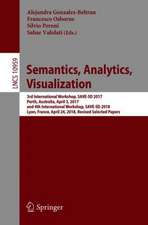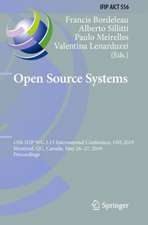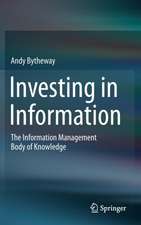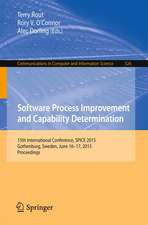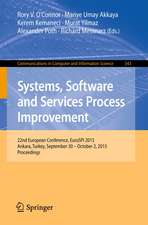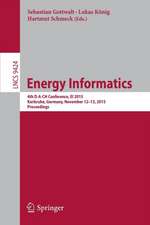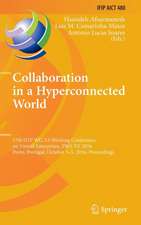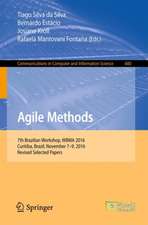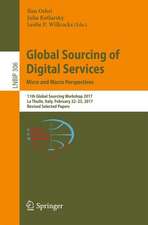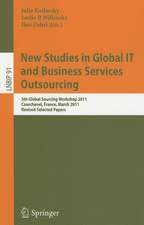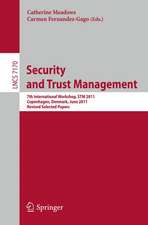Semantic Web Technologies and Legal Scholarly Publishing: Law, Governance and Technology Series, cartea 15
Autor Silvio Peronien Limba Engleză Hardback – 7 iul 2014
In particular, this work introduces EARMARK, a markup meta language that allows one to create markup documents without the structural and semantic limits imposed by markup languages such as XML. EARMARK is a platform to link the content layer of a document with its intended formal semantics and it can be used with the Semantic Publishing and Referencing (SPAR) Ontologies, another topic in this book. SPAR Ontologies are a collection of formal models providing an upper semantic layer for describing the publishing domain. Using EARMARK as a foundation for SPAR descriptions opens up to a semantic characterisation of all the aspects of a document and of its parts. Finally, four user-friendly tools are introduced: LODE, KC-Viz, Graffoo and Gaffe. They were expressly developed to facilitate the interaction of publishers and domain experts with Semantic Publishing technologies by shielding such users from the underlying formalisms and semantic models of such technologies.
| Toate formatele și edițiile | Preț | Express |
|---|---|---|
| Paperback (1) | 390.08 lei 6-8 săpt. | |
| Springer International Publishing – 10 sep 2016 | 390.08 lei 6-8 săpt. | |
| Hardback (1) | 397.59 lei 6-8 săpt. | |
| Springer International Publishing – 7 iul 2014 | 397.59 lei 6-8 săpt. |
Din seria Law, Governance and Technology Series
- 18%
 Preț: 950.33 lei
Preț: 950.33 lei - 24%
 Preț: 645.13 lei
Preț: 645.13 lei - 20%
 Preț: 691.10 lei
Preț: 691.10 lei - 20%
 Preț: 574.08 lei
Preț: 574.08 lei - 20%
 Preț: 879.83 lei
Preț: 879.83 lei - 20%
 Preț: 878.78 lei
Preț: 878.78 lei - 15%
 Preț: 720.23 lei
Preț: 720.23 lei - 18%
 Preț: 1122.56 lei
Preț: 1122.56 lei - 18%
 Preț: 1130.27 lei
Preț: 1130.27 lei - 15%
 Preț: 642.83 lei
Preț: 642.83 lei - 18%
 Preț: 950.52 lei
Preț: 950.52 lei - 18%
 Preț: 1009.85 lei
Preț: 1009.85 lei - 18%
 Preț: 1115.14 lei
Preț: 1115.14 lei - 15%
 Preț: 653.14 lei
Preț: 653.14 lei - 18%
 Preț: 949.23 lei
Preț: 949.23 lei - 18%
 Preț: 1014.76 lei
Preț: 1014.76 lei - 15%
 Preț: 638.43 lei
Preț: 638.43 lei - 18%
 Preț: 1124.30 lei
Preț: 1124.30 lei - 18%
 Preț: 1124.60 lei
Preț: 1124.60 lei - 18%
 Preț: 999.45 lei
Preț: 999.45 lei - 18%
 Preț: 892.42 lei
Preț: 892.42 lei - 15%
 Preț: 640.37 lei
Preț: 640.37 lei - 18%
 Preț: 947.35 lei
Preț: 947.35 lei - 20%
 Preț: 340.32 lei
Preț: 340.32 lei - 18%
 Preț: 1692.20 lei
Preț: 1692.20 lei - 18%
 Preț: 954.93 lei
Preț: 954.93 lei - 24%
 Preț: 789.37 lei
Preț: 789.37 lei - 20%
 Preț: 876.60 lei
Preț: 876.60 lei - 20%
 Preț: 652.41 lei
Preț: 652.41 lei - 18%
 Preț: 900.49 lei
Preț: 900.49 lei - 18%
 Preț: 941.50 lei
Preț: 941.50 lei -
 Preț: 392.97 lei
Preț: 392.97 lei
Preț: 397.59 lei
Nou
Puncte Express: 596
Preț estimativ în valută:
76.10€ • 82.69$ • 63.97£
76.10€ • 82.69$ • 63.97£
Carte tipărită la comandă
Livrare economică 21 aprilie-05 mai
Preluare comenzi: 021 569.72.76
Specificații
ISBN-13: 9783319047768
ISBN-10: 3319047760
Pagini: 328
Ilustrații: XXIII, 304 p. 211 illus., 46 illus. in color.
Dimensiuni: 155 x 235 x 23 mm
Greutate: 0.64 kg
Ediția:2014
Editura: Springer International Publishing
Colecția Springer
Seria Law, Governance and Technology Series
Locul publicării:Cham, Switzerland
ISBN-10: 3319047760
Pagini: 328
Ilustrații: XXIII, 304 p. 211 illus., 46 illus. in color.
Dimensiuni: 155 x 235 x 23 mm
Greutate: 0.64 kg
Ediția:2014
Editura: Springer International Publishing
Colecția Springer
Seria Law, Governance and Technology Series
Locul publicării:Cham, Switzerland
Public țintă
ResearchCuprins
Foreword.- Preface.- Acknowledgements.- Table of Contents.- List of Tables.- List of Figures.- 1 Introduction.- 2 The digital publishing revolution.- 3 Markup beyond the trees.- 4 Markup Semantics and Quality Evaluation of Legal Drafting.- 5 The Semantic Publishing and Referencing Ontologies.- 6 Semantic data interfaces for the masses.- 7 Conclusions.- Appendices.- Author's biography.- Index.
Textul de pe ultima copertă
This work deals with the applications of Semantic Publishing technologies in the legal domain, i.e., the use of Semantic Web technologies to address issues related to the Legal Scholarly Publishing. Research in the field of Law has a long tradition in the application of semantic technologies, such as Semantic Web and Linked Data, to real-world scenarios. This book investigates and proposes solutions for three main issues that Semantic Publishing needs to address within the context of the Legal Scholarly Publishing: the need of tools for linking document text to a formal representation of its meaning; the lack of complete metadata schemas for describing documents according to the publishing vocabulary; and the absence of effective tools and user interfaces for easily acting on semantic publishing models and theories.
In particular, this work introduces EARMARK, a markup metalanguage that allows one to create markup documents without the structural and semantic limits imposed by markup languages such as XML. EARMARK is a platform to link the content layer of a document with its intended formal semantics, and it can be used with the Semantic Publishing and Referencing (SPAR) Ontologies, another topic in this book. SPAR Ontologies are a collection of formal models providing an upper semantic layer for describing the publishing domain. Using EARMARK as a foundation for SPAR descriptions opens up to a semantic characterisation of all the aspects of a document and of its parts. Finally, four user-friendly tools are introduced: LODE, KC-Viz, Graffoo and Gaffe. They were expressly developed to facilitate the interaction of publishers and domain experts with Semantic Publishing technologies by shielding such users from the underlying formalisms and semantic models of such technologies.
In particular, this work introduces EARMARK, a markup metalanguage that allows one to create markup documents without the structural and semantic limits imposed by markup languages such as XML. EARMARK is a platform to link the content layer of a document with its intended formal semantics, and it can be used with the Semantic Publishing and Referencing (SPAR) Ontologies, another topic in this book. SPAR Ontologies are a collection of formal models providing an upper semantic layer for describing the publishing domain. Using EARMARK as a foundation for SPAR descriptions opens up to a semantic characterisation of all the aspects of a document and of its parts. Finally, four user-friendly tools are introduced: LODE, KC-Viz, Graffoo and Gaffe. They were expressly developed to facilitate the interaction of publishers and domain experts with Semantic Publishing technologies by shielding such users from the underlying formalisms and semantic models of such technologies.
Caracteristici
Presents a novel Semantic Web approach to overlapping markup and markup semantics Uses of diagrams and code excerpts to introduce the use of semantic publishing technologies and models Discusses applications of markup semantics to markup languages for legal document and quality assessment of legal drafting Includes supplementary material: sn.pub/extras




